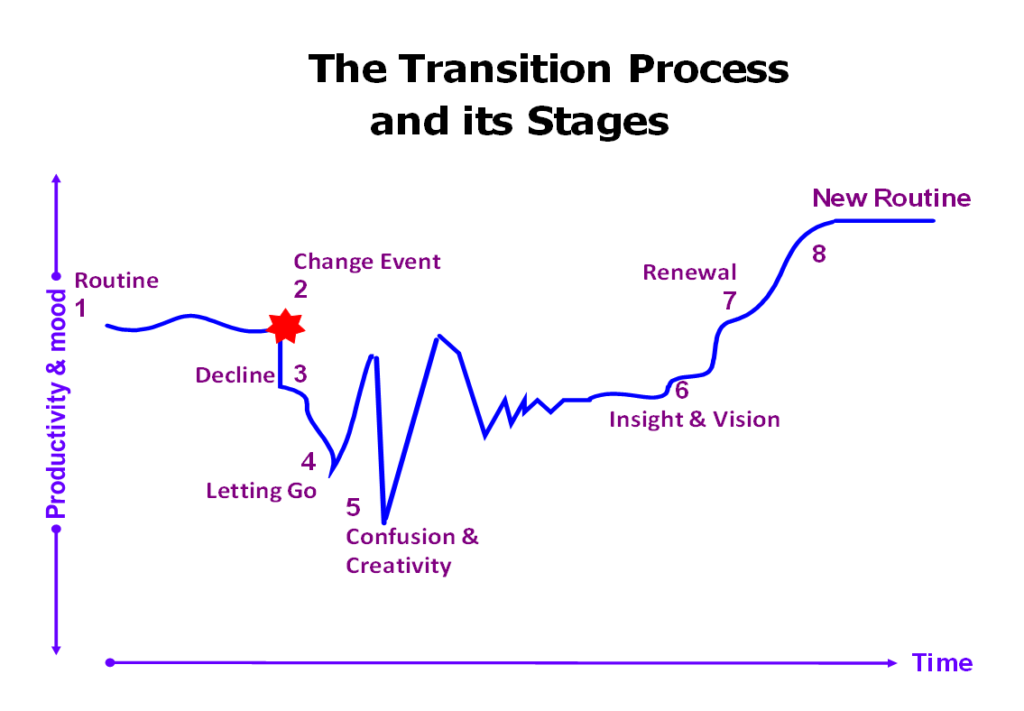
My energy during this time of isolation has been focused on what I have learned over the course of my career in leadership development that can benefit others the most right now. I keep landing on frameworks, and not just any frameworks. These are the rare schools of thought that create something revolutionary, both in terms of the knowledge represented, and its ability to shift thought to a new level.
In March, I talked about the importance of distributing knowledge versus having a less sustainable top-down approach in my article about The Starfish And The Spider. In April, I outlined the Cynefin Framework for Decision Making that is always powerful, and particularly in times of uncertainty.
Now we are few months into this new global environment, and while many organizations and news channels are talking about change, I hear the voice of William Bridges getting louder and louder in my memory:
From his book, The Way of Transition: Embracing Life’s Most Difficult Moments, Bridges writes:
We resist transition not because we can’t accept the change, but because we can’t accept letting go of that piece of ourselves that we have to give up when and because the situation has changed.
From his book, Transitions: Making Sense of Life’s Changes, Bridges writes:
In other words, change is situational. Transition, on the other hand, is psychological. It is not those events, but rather the inner reorientation and self-redefinition that you have to go through in order to incorporate any of those changes into your life. Without a transition, a change is just a rearrangement of the furniture. Unless transition happens, the change won’t work, because it doesn’t ‘take’.
It seems like the perfect time to hear these words again. Are you having trouble letting go of the way things were before this pandemic began? Are you finding more barriers than paths when you look toward the future? Do you spend time resisting the way things are and trying to find a way around or over the isolation wall?
These are all normal, healthy responses to a change event and Bridges’ Transition Curve gives us a framework that provides a path to follow versus a wall to keep bumping up against. The question that helps us shift from the change event to the transition is:
What is it time for me to let go of? (spend a few moments pondering this question or jotting down your answers if you are inspired to do so).
According to Bridges, change happens to individuals, which may cause resistant behaviors. Transition is a process individuals’ experience as they go through change:

Stage 1: Routine
During this stage, life is predictable, changes are few and minor and there are familiar concerns that are common.
Stage 2: Change Event
During this stage, and shocking event occurs and what used to be normal is not longer and we lose our ability to function effectively given the uncertainty. Sometimes this is the stage where there is denial, “It’s not fair!” “Why me?” etc.
Stage 3: Decline
During this stage there are high emotions of anger, grief, anxiety often followed by shock and refusal to hear new information. As we progress through this part of the curve questioning begins as productivity slows and there is a sense of isolation and overwhelm.
Stage 4: Letting Go
This is a conscious act as we accept that the routine we once knew is no longer and there is no going back. This release of “the way it was” stops the decline as one enhances awareness of the future.
Stage 5: Confusion and Creativity
During this stage, as our minds open there is more vulnerability as possibilities open up. It is an emotional roller coaster as depression and envisioning the future can happen side by side.
Stage 6: Insight and Vision
This stage is a breakthrough characterized by “Aha” moments and a focus on “what can be.” There may still be feelings of overwhelm but they are less frequent.
Stage 7: Renewal
This is the stage where we step into the uncertainty and move toward the new vision. Excitement and resilience build as we test ideas and develop new competence and relationships. Celebrations may occur during this stage.
Stage 8: New Routine
During this stage, a “new normal” is adopted. We refine our vision as we can learn from the past journey giving us more agility and flexibility for what is to come.
There are many complexities to this model and I will provide resources for a deeper dive if you would like to contact me, but for the purpose of this article, and this time in history, there is one point that is really important to understand about this remarkable body of work. This curve isn’t steps in an emotional state, but rather an energy state. One individual can be at numerous points of transition in various aspects of their life. There could be different paths forming for the virus, working from home, family life, changes in role, etc. It is very difficult to know where others are on this curve, but it is impossible to lead others if you don’t know where you are.
If you are on a team of any kind, at work, with your family, for a sport, and you are all looking at a common change event whether it be illness, job security, new members, new rules, it is critical not to bucket people and assume they are where you are in relationship to the same event. This is the number one pitfall I see in leaders. Leaders often talk about something for a while before they share it with those they lead so they have time to move through the curve and may expect others to catch up.
The good news is, when leaders understand this, it is one of the most powerful tools to lead successfully through times of great change. Leaders who have self-awareness and can assess where they are on the curve in relationship to a certain event, and then give others the time to do the same, are on the path to renewal. Leaders who understand that knowing where they are can change from moment to moment depending on new information and new, simultaneous change events, are going to be able to thrive in the face of uncertainty versus simply survive.
The quote by Bridges that I feel is most moving given where we currently stand as a global community is from his book, Transitions: Making Sense of Life’s Changes:
Transition always starts with an ending. To become something else, you have to stop being what you are now; to start doing things a new way, you have to end the way you are doing them now, and to develop a new attitude or outlook, you have to let go of the old.
So I repeat, what is it time for us to let go of?
Cynthia Lahti says
What a timely article! Thank you, Sheila, for the great work you do.
guidingleaders says
Thank you very much Cynthia, you’re comment means a great deal to me.